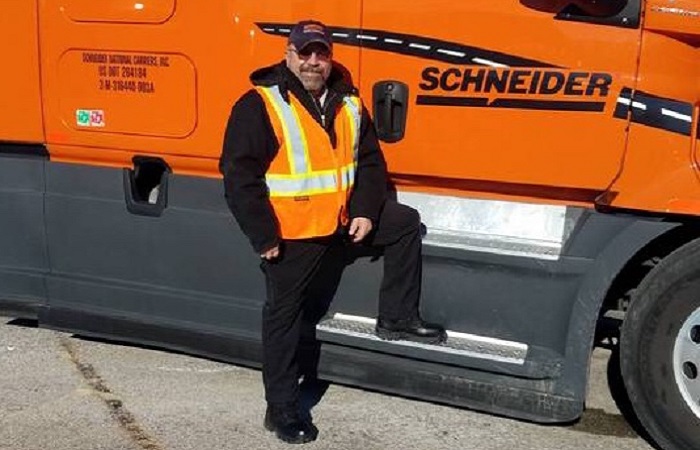Get Good Sleep and Stay Alive on the Road
Schneider truck driver discusses benefits of company’s obstructive sleep apnea treatment program.
Schneider truck driver discusses benefits of company’s obstructive sleep apnea treatment program.

Staying alive.
That is the first physical benefit Steven Frey, 55, listed when asked about using a CPAP (continuous positive airway pressure) machine.
Frey, a truck driver for Schneider, began using CPAP in 2007 as part of the company’s obstructive sleep apnea treatment program.
As many as 70 million people in the U.S. have a sleep disorder, and up to 90% of them are undiagnosed or untreated. People who are chronically sleep deprived are more likely to have health problems, including depression, obesity and cardiovascular disease.
Obstructive sleep apnea is a common sleep disorder that interferes with normal breathing and results in decreased restorative sleep and frequent drowsiness.
It can be a deadly disorder for someone like Frey, who needs to be well-rested and attentive when driving his big rig across the country.
“Life before CPAP was not good,” he said. “Without it, I would sleep eight to 10 hours a night and still feel tired all day. As a driver, you should be ready for any situation at any time.”
In fact, a study of investigations done by the National Transportation Safety Board found fatigue was a factor in 40% of highway crashes.
In 2006, Schneider became the first large-scale employer with a program to screen, diagnose and monitor adherence to obstructive sleep apnea treatment in the U.S.
A recent study – undertaken by the University of Minnesota-Morris, with contributions from the Harvard T.H. Chan School of Public Health, the Virginia Tech Transportation Institute, and Brigham and Women’s Hospital – illustrated that commercial truck drivers benefitted from an obstructive sleep apnea treatment program.
The study involved about 3,200 drivers, half with obstructive sleep apnea and half who were part of a control group. Results revealed the rate of serious, preventable crashes was five times higher among drivers with obstructive sleep apnea who did not adhere to a CPAP treatment program, compared with the control group.
In contrast, drivers with obstructive sleep apnea who were getting treatment shared a statistically similar crash rate as drivers in the control group.
That means for every 1,000 truck drivers, over the course of a year the drivers with untreated obstructive sleep apnea would have 70 crashes, compared to 14 crashes by those without sleep apnea and those who adhered to treatment for the disorder, concluded Stephen Burks, lead author of the research article and professor of economics and management at the University of Minnesota-Morris.
The significance of the results had an impact on Schneider.
“At Schneider, we’re driven by our No. 1 core value of Safety First and Always,” said Tom DiSalvi, vice president of safety and loss prevention at Schneider. “When you live and breathe that philosophy like we do, screening and treating drivers with sleep apnea is just the right thing to do. Clearly it makes our roads safer for both professional drivers and the motoring public, but the decreased risk of various other diseases and the overall feeling of being more rested and energized also enhance the quality of life for drivers.”
It takes Frey about five minutes to set up his CPAP. The only thing he has to do is add distilled water to the humidifier feature. He said he uses CPAP every night and when he takes an afternoon nap, whether he is on the road or at home.
“As a CPAP user, being well-rested makes me a safer driver for plenty of reasons,” he said. “Fatigue can be a downfall for any driver. Getting the proper amount of sleep is essential for the safe operation of [a] commercial vehicle. A driver makes approximately 200 decisions every mile; with good sleep, we are better able to make the right decisions.”
Schneider requires all new drivers to be screened for obstructive sleep apnea. Treatment cost is covered with no out-of-pocket expense through the company’s health insurance program. The same goes for drivers diagnosed with other sleep disorders, such as insomnia.
Obstructive sleep apnea treatment at Schneider has resulted in a 48% reduction in health care spending per member, per month. In addition, retention of treated drivers was 60% better than fleet average.
Frey said keeping drivers healthy is key to having a safe company.
“I came to Schneider because this company is all about safety,” he said. “We truly care about the safety of the driver and the motoring public.”
Learn More
Find out how much fatigue may be costing your company with the National Safety Council Fatigue Cost Calculator, and learn more about sleep disorders with the Sleep Disorders Fact Sheet.
A Workplace Fatigue Conference will take place Wednesday and Thursday, Feb. 20 and 21, in Seattle. It will be preceded by the 2019 Campbell Institute Symposium, which starts Tuesday, Feb. 19. Featured topics at the Workplace Fatigue Conference will include fatigue risk management systems, sleep health promotion in the workplace, fatigue and technology, and regulatory and legislative policy change. To learn more, click here.
With a century-long legacy, the National Safety Council is a global center for safety expertise. Let's work together to align resources. We look forward to learning about ways we can join efforts to expand safety everywhere!
There are no items in your cart